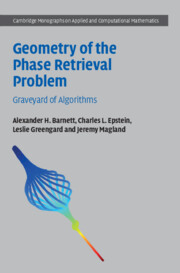Book contents
- Frontmatter
- Contents
- Preface
- Acknowledgments
- 1 Introduction
- Part I Theoretical Foundations
- 2 The Geometry Near an Intersection
- 3 Well-Posedness
- 4 Uniqueness and the Nonnegativity Constraint
- 5 Some Preliminary Conclusions
- Part II Analysis of Algorithms for Phase Retrieval
- Part III Further Properties of Hybrid Iterative Algorithms and Suggestions for Improvement
- References
- Index
2 - The Geometry Near an Intersection
from Part I - Theoretical Foundations
Published online by Cambridge University Press: 21 April 2022
- Frontmatter
- Contents
- Preface
- Acknowledgments
- 1 Introduction
- Part I Theoretical Foundations
- 2 The Geometry Near an Intersection
- 3 Well-Posedness
- 4 Uniqueness and the Nonnegativity Constraint
- 5 Some Preliminary Conclusions
- Part II Analysis of Algorithms for Phase Retrieval
- Part III Further Properties of Hybrid Iterative Algorithms and Suggestions for Improvement
- References
- Index
Summary
The phase retrieval problem is the problem of finding the intersections between a high-dimensional magnitude torus, A, in a Euclidean space and a second set, B, defined by the auxiliary data. The problem is difficult because the set A is not convex. In this chapter we give a very explicit description of the tangent and normal bundles of the torus in both the image-space and Fourier representations. Using this description, we show that, for practical support constraints, the intersections between A and B are not usually transversal. The chapter concludes with numerical examples demonstrating this phenomenon, with various types of images and support constraints. The chapter closes with appendices on the tangent and normal bundles of submanifolds of Euclidean spaces, and a fast algorithm for finding the orthogonal projections onto the tangent and normal bundles of a magnitude torus.
- Type
- Chapter
- Information
- Geometry of the Phase Retrieval ProblemGraveyard of Algorithms, pp. 39 - 64Publisher: Cambridge University PressPrint publication year: 2022

